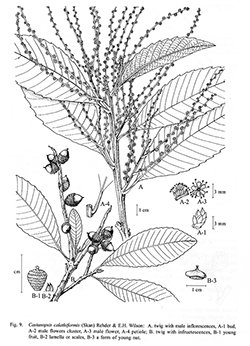e-Flora of Thailand
Volume 9 > Part 3 > Year 2008 > Page 193 > Fagaceae > Castanopsis
6. Castanopsis calathiformis (Skan) Rehder & E.H.Wilsonwfo-0000812946
in C.S. Sargent, Pl. Wilson. 3: 204. 1916; Barnett, Quer. Rel. Fag. Asia: 191a. 1940; Trans. & Proc. Bot. Soc. Edinburgh 34: 336. 1944; C.C.Huang, Y.T.Chang & B.M.Bartol. in C.Y.Wu & P.H.Raven, Fl. China 4: 320. 1999.— Quercus calathiformis Skan, J. Linn. Soc. 26: 508. 1899.— Synaedrys calathiformis (Skan) Koidz., Bot. Mag. (Tokyo) 30: 188. 1916.— Pasania calathiformis (Skan) Hickel & A.Camus, Ann. Sci. Nat. Bot. 3: 408. 1921; Fl. Indo-Chine 5: 1004. 1930.— Lithocarpus calathiformis (Skan) A.Camus, Rivièra Sci. 18: 40. 1931.Fig. 9.
Accepted Name : This is currently accepted.
Description : Tree, 6–20 m high, 100–200 cm girth. Terminal buds ovoid, hairy outside. Twigs stout, quadrangular, pubescent then glabrescent, sparsely lenticellate. Bark brown, fissured. Leaves obovate or oblanceolate, 14–20 by 5–9 cm; base cuneate; apex obtuse or broadly acute; margins serrate; coriaceous, glabrous, glossy green on the upper surface and pale on the lower; midrib and lateral nerves prominent on the lower surface and depressed on the upper; lateral nerves 14–22 pairs, straight and reaching the points of serrate margins, scalariform veins conspicious on the lower surface. Petiole slender, 1–3 cm long, eglandular, pubescent then glabrescent. Inflorescences male and female separate or mixed. Male inflorescence always branched, terminal or axillary, spikelets 4–10 cm long. Male flowers white or whitish-yellow, in 2–5 flowered cluster; calyx 6-lobed, lobes obovate, free, ca 1.5 by 0.5 mm, glabrous; stamens 12, 1.5–2 mm long; bracts ovate, ca 2 by 1.5 mm glabrous; rudimentary ovary 3-lobed, villous. Female inflorescence spike, axillary, up to 8 cm long. Female flowers not clustered, other characters as in male flowers; styles 3(4) ca 1 mm long; stigmata divergent, all glabrous. Fruits sessile, ovoid, 1–1.6 by 1–1.2 cm, (including cupule), on erect infructescence 15–20 cm long. Cupule enclosing up to ½ of the nut; wall with thin imbricate scales or lamella, the latter acute, free and erect at apex. Nut 1, ovoid, rarely flattened, 1–1.5 by 0.9–1.5 cm, glabrous except around the umbo.
Thailand : NORTHERN: Chiang Mai, Lampang.
Distribution : China (Yunnan – type), Laos, Vietnam.
Ecology : In moist upper mixed deciduous forests, hill evergreen forests, lower montane rain forests, on granite bedrock, 700–2,000 m (most commonly 1,800–2,000 m). Flowering: January–May (most commonly April–May); fruiting: April–December (most commonly July–October).
Vernacular : Ko mu doi (ก่อหมูดอย), ko khi mu (ก่อขี้หมู), ko nam (ก่อน้ำ), ko ta mu (ก่อตาหมู)(Northern).
Uses: Nuts edible.

